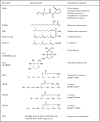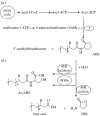Quorum-quenching microbial infections: mechanisms and implications
- PMID: 17360274
- PMCID: PMC2435583
- DOI: 10.1098/rstb.2007.2045
Quorum-quenching microbial infections: mechanisms and implications
Abstract
The discovery of antibiotics early in the past century marked the beginning of active control and prevention of infectious microbial diseases. However, extensive use of antibiotics has also unavoidably resulted in the emergence of ‘superbugs’ that resist conventional antibiotics. The finding that many pathogens rely on cell-to-cell communication mechanisms, known as quorum sensing, to synchronize microbial activities essential for infection and survival in the host suggests a promising disease control strategy, i.e. quenching microbial quorum sensing or in short, quorum quenching. Work over the past few years has demonstrated that quorum-quenching mechanisms are widely conserved in many prokaryotic and eukaryotic organisms. These naturally occurring quorum-quenching mechanisms appear to play important roles in microbe–microbe and pathogen–host interactions and have been used, or served as lead compounds, in developing and formulating a new generation of antimicrobials. Characterization of the crystal structures of several types of quorum-quenching enzymes has provided valuable information to elucidate the catalytic mechanisms, as well as clues for future protein tailoring and molecular improvement. The discovery of quorum-sensing signal degradation enzymes in mammalian species represents a new milestone in quorum sensing and quorum quenching research. The finding highlights the importance of investigating their roles in host innate defence against infectious diseases and to determine the factors influencing their in vivo concentrations and catalytic activities.
Figures



Similar articles
-
Pharmacological inhibition of quorum sensing for the treatment of chronic bacterial infections.J Clin Invest. 2003 Nov;112(9):1300-7. doi: 10.1172/JCI20074. J Clin Invest. 2003. PMID: 14597754 Free PMC article. Review.
-
A new phenothiazine structural scaffold as inhibitors of bacterial quorum sensing in Vibrio harveyi.Biochem Biophys Res Commun. 2009 Apr 24;382(1):153-6. doi: 10.1016/j.bbrc.2009.02.157. Epub 2009 Mar 4. Biochem Biophys Res Commun. 2009. PMID: 19268431
-
Targeting agr- and agr-Like quorum sensing systems for development of common therapeutics to treat multiple gram-positive bacterial infections.Sensors (Basel). 2013 Apr 18;13(4):5130-66. doi: 10.3390/s130405130. Sensors (Basel). 2013. PMID: 23598501 Free PMC article. Review.
-
Quorum sensing and quorum-quenching enzymes.J Microbiol. 2005 Feb;43 Spec No:101-9. J Microbiol. 2005. PMID: 15765063 Review.
-
Structural understanding of quorum-sensing inhibitors by molecular modeling study in Pseudomonas aeruginosa.Appl Microbiol Biotechnol. 2009 Jul;83(6):1095-103. doi: 10.1007/s00253-009-1954-3. Epub 2009 Mar 28. Appl Microbiol Biotechnol. 2009. PMID: 19330325
Cited by
-
The virulence factor regulator and quorum sensing regulate the type I-F CRISPR-Cas mediated horizontal gene transfer in Pseudomonas aeruginosa.Front Microbiol. 2022 Sep 30;13:987656. doi: 10.3389/fmicb.2022.987656. eCollection 2022. Front Microbiol. 2022. PMID: 36246261 Free PMC article.
-
Quorum sensing and social networking in the microbial world.J R Soc Interface. 2009 Nov 6;6(40):959-78. doi: 10.1098/rsif.2009.0203. Epub 2009 Aug 12. J R Soc Interface. 2009. PMID: 19674996 Free PMC article. Review.
-
Competition/antagonism associations of biofilm formation among Staphylococcus epidermidis Agr groups I, II, and III.J Microbiol. 2019 Feb;57(2):143-153. doi: 10.1007/s12275-019-8322-5. Epub 2019 Jan 31. J Microbiol. 2019. PMID: 30706343
-
Identification of a Second Type of AHL-lactonase from Rhodococcus sp. BH4, belonging to the α/β Hydrolase Superfamily.J Microbiol Biotechnol. 2020 Jun 28;30(6):937-945. doi: 10.4014/jmb.2001.01006. J Microbiol Biotechnol. 2020. PMID: 32160697 Free PMC article.
-
Involvement of multiple loci in quorum quenching of autoinducer I molecules in the nitrogen-fixing symbiont Rhizobium (Sinorhizobium) sp. strain NGR234.Appl Environ Microbiol. 2011 Aug;77(15):5089-99. doi: 10.1128/AEM.00112-11. Epub 2011 Jun 3. Appl Environ Microbiol. 2011. PMID: 21642401 Free PMC article.
References
-
- Aendekerk S, Ghysels B, Cornelis P, Baysse C. Characterization of a new efflux pump, MexGHI–OpmD, from Pseudomonas aeruginosa that confers resistance to vanadium. Microbiology. 2002;148:2371–2381. - PubMed
-
- Billecke S, Draganov D, Counsell R, Stetson P, Watson C, Hsu C, La Du B.N. Human serum paraoxonase (PON1) isozymes Q and R hydrolyze lactones and cyclic carbonate esters. Drug Metab. Dispos. 2000;28:1335–1342. - PubMed
-
- Bjarnsholt T, Givskov M. Quorum-sensing blockade as a strategy for enhancing host defences against bacterial pathogens. Phil. Trans. R. Soc. B. 2007;362:1213–1222. doi:10.1098/rstb.2007.2046 - DOI - PMC - PubMed
-
- Cameron A.D, Ridderstrom M, Olin B, Mannervik B. Crystal structure of human glyoxalase II and its complex with a glutathione thiolester substrate analogue. Structure. 1999;7:1067–1078. doi:10.1016/S0969-2126(99)80174-9 - DOI - PubMed
-
- Carlier A, Uroz S, Smadja B, Fray R, Latour X, Dessaux Y, Faure D. The Ti plasmid of Agrobacterium tumefaciens harbors an attM-paralogous gene, aiiB, also encoding N-acyl homoserine lactonase activity. Appl. Environ. Microbiol. 2003;69:4989–4993. doi:10.1128/AEM.69.8.4989-4993.2003 - DOI - PMC - PubMed
Publication types
MeSH terms
Substances
LinkOut - more resources
Full Text Sources
Other Literature Sources
Medical
Miscellaneous

